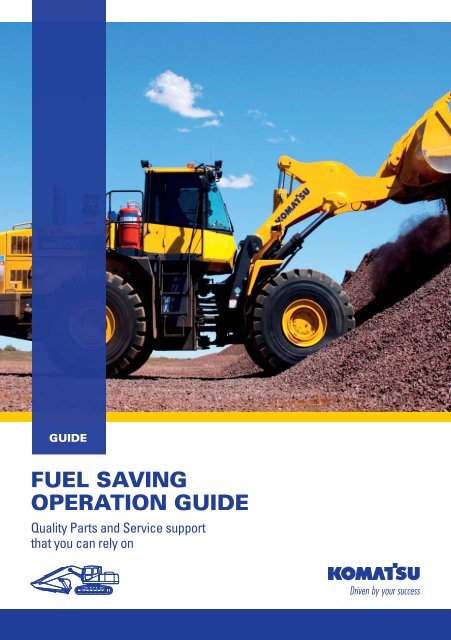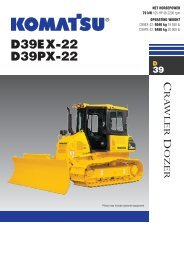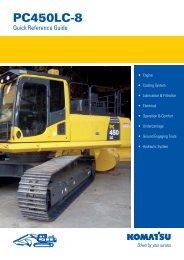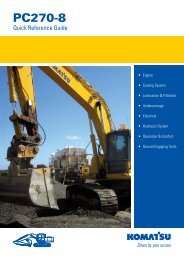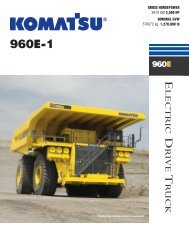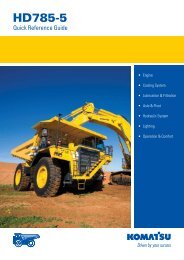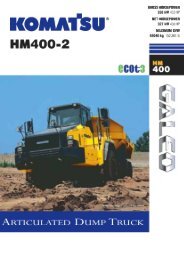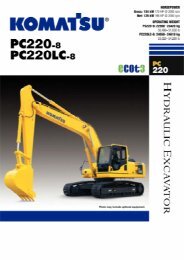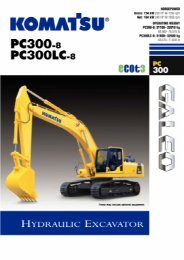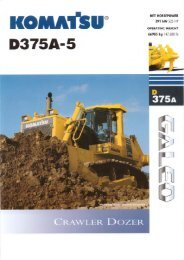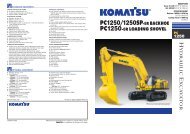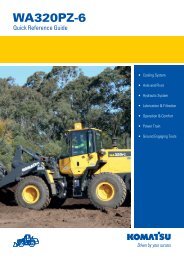FUEL SAVING OPERATION GUIDE - Komatsu
FUEL SAVING OPERATION GUIDE - Komatsu
FUEL SAVING OPERATION GUIDE - Komatsu
Create successful ePaper yourself
Turn your PDF publications into a flip-book with our unique Google optimized e-Paper software.
<strong>GUIDE</strong><br />
<strong>FUEL</strong> <strong>SAVING</strong><br />
<strong>OPERATION</strong> <strong>GUIDE</strong><br />
Quality Parts and Service support<br />
that you can rely on
CONTENTS<br />
Introduction······························································································ 3<br />
MACHINE <strong>OPERATION</strong> FOR <strong>FUEL</strong> <strong>SAVING</strong>S ······················ 4<br />
1.1 HYDRAULIC EXCAVATOR··························································· 6<br />
1. IDLING································································································· 7<br />
2. DIGGING ····························································································· 8<br />
3. DIGGING & LOADING ·································································· 9, 10<br />
4. LOADING ·························································································· 11<br />
5. TRAVELING······················································································· 12<br />
1.2 WHEEL LOADER········································································· 14<br />
1. IDLING······························································································· 15<br />
2. DIGGING ····················································································· 16, 17<br />
3. LOADING ·························································································· 18<br />
4. TRAVELING······················································································· 19<br />
1.3 DUMP TRUCK············································································· 20<br />
1. IDLING······························································································· 21<br />
2. DRIVING······················································································ 22, 23<br />
3. TRAVELING················································································· 24, 25<br />
4. DUMPING·························································································· 26<br />
5. POWER SELECTION········································································ 27<br />
- 1 -
MAINTENANCE FOR <strong>FUEL</strong> <strong>SAVING</strong>S·········································· 28<br />
1. Basics of Maintenance Work ····························································· 29<br />
2. Engine ··················································································· 30, 31, 32<br />
(1) Air cleaner<br />
(2) Fuel injection timing<br />
(3) Valve clearance<br />
(4) Injection nozzle<br />
3. Fuel System················································································· 33, 34<br />
(1) Filter element<br />
(2) Strainer<br />
(3) Draining water<br />
4. Undercarriage (Hydraulic Excavator)················································· 35<br />
5. Tires (Wheel Loader & Dump Truck) ··········································· 36, 37<br />
6. Oil Maintenance··········································································· 38, 39<br />
(1) Oil viscosity<br />
(2) Oil replacement interval<br />
7. Management for Fuel Savings (Dump Truck)······································ 40<br />
- 2 -
Introduction<br />
Global warming due to increasing concentrations of greenhouse<br />
gases in the atmosphere has become a major issue in recent years.<br />
Also, fuel consumption is a major concern for <strong>Komatsu</strong>’s<br />
customers from an economical point of view.<br />
In response, <strong>Komatsu</strong> has been focusing on decreasing exhaust<br />
emissions as one of its top priorities in product development, and<br />
conducted research on machine work methods in order to reduce<br />
exhaust emissions through improved fuel efficiency.<br />
This guide provides the essential knowledge and know-how about<br />
the operation for saving fuel or better fuel efficiency. Please<br />
review your machine operation once again, and practice<br />
fuel-saving-operation according to these guidelines. Satisfaction<br />
will definitely be a positive result.<br />
Fuel management is in your hands now!<br />
The fuel efficiency statistics displayed herein may vary depending<br />
on the actual work site, machine condition and operator skill.<br />
- 3 -
MACHINE <strong>OPERATION</strong><br />
FOR <strong>FUEL</strong> <strong>SAVING</strong>S<br />
- 4 -
- 5 -
1.1 HYDRAULIC EXCAVATOR<br />
- 6 -
1. IDLING<br />
- 7 -<br />
HYDRAULIC EXCAVATOR<br />
ADVICE<br />
Stop the engine as much as possible.<br />
Do not leave the engine idling during<br />
waiting times or breaks.<br />
KEY POINT<br />
While it is necessary to keep an engine idling for 5 minutes right<br />
after startup and right before shutting down, unnecessary engine<br />
idling consumes fuel for no reason.<br />
TEST DATA<br />
<br />
When idling 0.76 L / H<br />
When idling<br />
in auto deceleration mode<br />
3.30 L / H<br />
Conditions: 1 hour engine idling reduction per day and 25 work days per month<br />
This fuel consumption amount will further increase if a machine is idling in the auto deceleration *1<br />
mode, i.e., it consumes approx. 3.3 liters an hour.<br />
REMARKS<br />
Switch off<br />
Avoid unnecessary engine idling.<br />
228 L / Year<br />
990 L / Year<br />
*1 Auto Decel Idling:<br />
Auto deceleration is a function built into <strong>Komatsu</strong> hydraulic excavators (above 10-ton class).<br />
It serves to automatically reduce the engine revolution to the medium speed when the control<br />
lever is left in the neutral position for 4 seconds such as when the machine is waiting for a dump<br />
truck, thereby lowering fuel consumption and noise.<br />
(Example)<br />
Engine Revolution (PC200-7)<br />
: When idling 980 – 1080 rpm<br />
: When idling in auto deceleration mode 1300 – 1500 rpm
2. DIGGING<br />
- 8 -<br />
HYDRAULIC EXCAVATOR<br />
ADVICE<br />
Avoid relieving hydraulic pressure as much<br />
as possible.<br />
Aim at smooth digging by lessening the<br />
load.<br />
KEY POINT<br />
When a load from a single dig is too big, the work equipment will<br />
not work even though the control lever is kept engaged, as<br />
hydraulic pressure is relieved.<br />
*1 When hydraulic pressure is relieved, the bucket does not scoop<br />
sand and earth, i.e., no work can be done, nonetheless fuel is still<br />
consumed.<br />
TEST DATA<br />
<br />
When hydraulic pressure is relieved 28 L / H<br />
Conditions: 6 min. Hydraulic pressure relief reduction per day and 25 work days per month.<br />
REMARKS<br />
840 L / Year<br />
*1 Hydraulic Pressure Relief:<br />
It means that the relief valve to the tank circuit is open. Under this condition, work equipment force<br />
will not increase, but stay the same.
HYDRAULIC EXCAVATOR<br />
3. DIGGING & LOADING<br />
ADVICE<br />
Reduce engine speed.<br />
Use E Mode *1 .<br />
KEY POINT<br />
In the same operation, lower engine speed, requires less consumption.<br />
Lower engine speed reduces productivity as well, but compensates<br />
with improved fuel efficiency.<br />
TEST DATA<br />
<br />
(Conditions)<br />
1. Loading a dump truck parked on the same ground level (height).<br />
2. Digging downward<br />
3. Loading a dump truck using 90° swing angles<br />
4. Sand and earth to be dug out<br />
Fuel efficiency can vary depending on the kind of sand and earth to be dug out.<br />
REMARKS<br />
*1. E Mode (Eco Mode):<br />
This is a function built into <strong>Komatsu</strong>’s 20-ton class hydraulic excavators. In this mode, the engine<br />
power is used at approx. 85% of the full throttle. (It is effective for reducing fuel costs and noise.)<br />
*2. Fuel Efficiency (tons per liter):<br />
Production per Fuel Consumption<br />
- 9 -
HYDRAULIC EXCAVATOR<br />
3. DIGGING & LOADING<br />
ADVICE<br />
Raise excavation position.<br />
Conduct two-tiered excavation.<br />
KEY POINT<br />
The bench height should be the same height or slightly higher than<br />
the dump truck body. Excavating the upper side of the slope first<br />
and then working on the exposed lower portion shortens cycle time<br />
compared with slope toe excavation.<br />
TEST DATA<br />
Conventional Recommended<br />
Slope Toe Excavation Two-tiered slope Excavation<br />
<br />
(Conditions)<br />
1. Loading a dump truck parked on a lower ground level.<br />
2. Digging downward<br />
3. Loading a dump truck using 90° swing angles<br />
4. Sand and earth to be dug out<br />
Fuel efficiency varies depending on the kind of sand and earth to be dug out.<br />
REMARKS<br />
*1. Fuel Efficiency (tons per liter):<br />
Production per Fuel Consumption<br />
- 10 -
4. LOADING<br />
ADVICE<br />
Reduce swing angle.<br />
Be closer to a dump truck.<br />
- 11 -<br />
HYDRAULIC EXCAVATOR<br />
KEY POINT<br />
When loading dump trucks, reducing the swing angle can<br />
accelerate the cycle time, boost hourly productivity and raise fuel<br />
efficiency *1 .<br />
TEST DATA<br />
<br />
REMARKS<br />
90°<br />
*1. Fuel Efficiency (tons per liter):<br />
Production per Fuel Consumption<br />
30°<br />
0°
5. TRAVELING<br />
ADVICE<br />
Travel at lower speeds.<br />
- 12 -<br />
HYDRAULIC EXCAVATOR<br />
KEY POINT<br />
Higher travel speeds mean higher engine revolutions, expending<br />
more fuel. Conversely, lowering the engine speed improves<br />
traveling fuel efficiency* 1 .<br />
TEST DATA<br />
<br />
REMARKS<br />
Slower<br />
*1. Fuel Efficiency = Travel Distance / Amount of Fuel Consumed
- 13 -
1. 2 WHEEL LOADER<br />
- 14 -
1. IDLING<br />
- 15 -<br />
WHEEL LOADER<br />
ADVICE<br />
Stop the engine as much as possible.<br />
Do not leave the engine idling during<br />
waiting times or breaks.<br />
KEY POINT<br />
While it is necessary to keep an engine idling for 5 minutes right<br />
after startup and right before shutting down, unnecessary engine<br />
idling consumes fuel for no reason.<br />
TEST DATA<br />
< Annual fuel savings ><br />
Idling fuel consumption 4.20 L / H<br />
Switch off<br />
Avoid unnecessary engine idling.<br />
1260 L / Year<br />
Conditions: 1 hour engine idling reduction per day and 25 work days per month
2. DIGGING<br />
- 16 -<br />
WHEEL LOADER<br />
ADVICE<br />
Avoid relieving hydraulic pressure and torque<br />
converter stall.<br />
KEY POINT<br />
When sand and earth to be dug out imposes too big of a load, the<br />
work equipment will not move even though the control lever is kept<br />
engaged, as the torque converter stalls and hydraulic pressure is<br />
relieved.<br />
More fuel is consumed in a combination of releving hydraulic pressure* 1<br />
and torque converter stall* 2 than in the use of V shape loading.<br />
TEST DATA<br />
<br />
30° V shape loading 28 L / H<br />
Relieving hydraulic pressure<br />
relief and torque converter stall<br />
43 L / H<br />
Conditions: 30 minutes hydraulic pressure relief reduction per day and 25 work days per month<br />
REMARKS<br />
6450 L / Year<br />
*1. Hydraulic pressure relief:<br />
It means that the relief valve to the tank circuit is open. Hydraulic pressure will not rise while the<br />
valve is open.<br />
*2. Torque converter stall:<br />
This term refers to the condition of torque converter when a machine stops while the engine is still<br />
running due to some external force.
2. DIGGING<br />
ADVICE<br />
Avoid tire slippage.<br />
- 17 -<br />
WHEEL LOADER<br />
KEY POINT<br />
The tires of a wheel loader tend to slip when it grinds to a halt while<br />
digging and the engine is revved to still move it forward. When the<br />
tires slip, the bucket can no longer dig into sand and earth and<br />
scoop. Prolonged tire slippage consumes fuel for no reason.<br />
(1) If the bucket is pressed hard against the ground during the digging<br />
work, the front wheels lift off the ground (consequently, the load on<br />
the front wheels diminishes), which in turn makes it easier for them<br />
to slip. Before digging into sand and earth, hold the bucket slightly<br />
off the ground.<br />
(2) When the tires show signs of slipping, release the accelerator<br />
pedal slightly and press on the accelerator pedal gradually to raise<br />
the engine revolution up to a level right before slipping, thereby<br />
digging into the ground and scooping sand and earth.<br />
(3) If the tires begin to slip, release the accelerator pedal once and<br />
step on it again gradually to dig and scoop as explained above.
3. LOADING<br />
ADVICE<br />
Shorten the loading distance.<br />
Minimize the loading V-angle.<br />
KEY POINT<br />
Optimum: Distance 0.8L<br />
Angle 30°<br />
TEST DATA<br />
- 18 -<br />
WHEEL LOADER<br />
Conditions:<br />
1. 30° V shape loading<br />
2. Forward and reverse travel distance classified into three stages (L = machine overall length)<br />
REMARKS<br />
*1. Fuel Efficiency (tons per liter):<br />
Production per Fuel Consumption
4. TRAVELING<br />
ADVICE<br />
Travel at lower speeds.<br />
- 19 -<br />
WHEEL LOADER<br />
KEY POINT<br />
Higher travel speeds mean higher engine revolutions, expending<br />
more fuel. Conversely, lowering the engine speed improves<br />
traveling fuel efficiency *1 .<br />
TEST DATA<br />
Conditions:<br />
1. Load & Carry operation.<br />
2. Bucket filled with sand and earth<br />
3. Travel distance of 95 m<br />
REMARKS<br />
*1. Fuel Efficiency (tons per liter):<br />
Production per Fuel Consumption
1.3 DUMP TRUCK<br />
- 20 -
1. IDLING<br />
- 21 -<br />
DUMP TRUCK<br />
ADVICE<br />
Stop the engine as much as possible.<br />
Do not leave the engine idling during<br />
waiting times or breaks.<br />
KEY POINT<br />
While it is necessary to keep an engine idling for 5 minutes right<br />
after the startup and right before shutting down, unnecessary<br />
engine idling consumes fuel for no reason.<br />
TEST DATA<br />
<br />
When idling 8 L / H<br />
Switch off<br />
Avoid unnecessary engine idling.<br />
2400 L / Year<br />
Conditions: 1 hour engine idling reduction per day and 25 work days per month
2. DRIVING<br />
- 22 -<br />
DUMP TRUCK<br />
ADVICE<br />
Drive with coasting.<br />
KEY POINT<br />
No fuel is consumed by releasing the acceleration pedal and<br />
applying the engine brake while driving.<br />
(1) Normal driving Fig. 1<br />
Initial Speed 30 km/h<br />
Fuel is consumed until dump truck stops.<br />
(2) Coasting Fig. 2<br />
A driving technique enabling a coasting distance created by the initial speed that<br />
can help save fuel.<br />
TEST DATA<br />
Fuel is consumed as the<br />
accelerator pedal is depressed.<br />
The retarder brake<br />
begins to work.<br />
Fuel Cutoff<br />
Beginning of Coasting No fuel is injected for this portion of running.<br />
Fuel Cutoff<br />
When a dump truck is going down a slope, the driver<br />
is required to select an appropriate safety speed,<br />
taking into account the initial running speed and<br />
slope inclination.<br />
Never coast on a downslope.<br />
Stop Point<br />
Initial Speed 30 km/h Stop Point<br />
2. DRIVING<br />
- 23 -<br />
DUMP TRUCK<br />
ADVICE<br />
Drive at a constant speed.<br />
Do not accelerate and decelerate frequently.<br />
KEY POINT<br />
(1) Driving at constant speed Fig. 1<br />
Driving at a constant speed to minimize variations in running speed less fuel<br />
consumption.<br />
(2) Frequent acceleration and deceleration Fig. 2<br />
Acceleration Deceleration<br />
Acceleration<br />
Repeated acceleration and deceleration reduces fuel efficiency.<br />
TEST DATA<br />
<br />
Running at a constant speed<br />
Conditions: Alternating speeding up and slowing down twice between 20 km/h and 30 km/h in a<br />
300 m distance
3. TRAVELING<br />
ADVICE<br />
Travel at lower speeds.<br />
- 24 -<br />
DUMP TRUCK<br />
Recommended Slow<br />
Not<br />
Recommended<br />
KEY POINT<br />
Higher travel speeds mean higher engine revolutions, expending<br />
more fuel. Conversely, lowering the engine speed improves traveling<br />
fuel efficiency.<br />
It takes more time when a dump truck is running at a lower speed,<br />
but the time saved could easily be wasted for reason if waiting at its<br />
destination for loading or dumping.<br />
TEST DATA<br />
<br />
Fast<br />
Conditions: Running for a 100 m distance at a speed of 30 km/h and 40 km/h, respectively
3. TRAVELING<br />
- 25 -<br />
DUMP TRUCK<br />
ADVICE<br />
Switch off the exhaust brake when coasting<br />
on a flat road assuring safty.(If equipped)<br />
KEY POINT<br />
Exhaust Switch<br />
OFF<br />
Exhaust Switch<br />
ON<br />
The use of the exhaust brake curtails the coasting distance.<br />
REMARKS<br />
Exhaust Brake<br />
The exhaust brake works by applying resistance to the exhaust from the engine. It is activated<br />
when the torque converter is in the lockup* condition.<br />
*Lockup means that engine output is directly transmitted to the transmission, bypassing the<br />
torque converter. The function can be turned on and off with a switch inside the operator’s cab.<br />
Table for Operating Exhaust Brake<br />
Exhaust Brake<br />
Switch<br />
Beginning of coasting<br />
Beginning of coasting /<br />
Exhaust brake applied<br />
Switch<br />
Condition<br />
Switch<br />
Lamp<br />
ON Pressed in Light up<br />
OFF Pressed out Go off<br />
Fuel cutoff for this distance<br />
Fuel cutoff for<br />
this distance<br />
Stop<br />
Fuel is still consumed because the<br />
accelerator pedal remains depressed,<br />
as the dump truck falls short of the<br />
stop point.<br />
Stop<br />
Condition for Activation<br />
Activated when the foot is released<br />
from the accelerator pedal<br />
Activated together with the service<br />
brake or retarder brake
4. DUMPING<br />
- 26 -<br />
DUMP TRUCK<br />
ADVICE<br />
Make sure to carry out dumping at a lower<br />
engine speed!<br />
KEY POINT<br />
In dumping, a lifting speed of the body changes in proportion to the<br />
engine revolution. Therefore the faster the body rises, the more<br />
fuel the engine consumes.<br />
In the dumping operation, at 80% of the max. engine revolution,<br />
fuel can be saved by as much as 45%, as compared with dumping<br />
at the max. engine revolution.<br />
TEST DATA<br />
<br />
Carry out dumping at a<br />
lower engine speed for<br />
less fuel consumption!
5. POWER SELECTION<br />
- 27 -<br />
DUMP TRUCK<br />
ADVICE<br />
Use Economy Mode for better fuel economy!<br />
KEY POINT<br />
This is a function <strong>Komatsu</strong> dump trucks are equipped with, which<br />
allows an operator to select either the max. or 85% of engine output.<br />
● High Power Mode<br />
A mode to enable the engine to exert its max. power, thereby<br />
maximizing the workload. (Best suited to a jobsite that requires a<br />
dump truck to climb up a slope with a load)<br />
● Economy Mode<br />
A mode to limit the engine power to 85% of its max. power,<br />
aiming at fuel savings. In addition, the shift-up and shift-down<br />
points are set low to keep engine running low. (Best suited to<br />
work on a level ground that does not require the max. engine<br />
power and focuses on achieving fuel economy)<br />
More time is required for the work to the extent that the engine is<br />
throttled down, but this mode also demonstrates a fue-saving effect<br />
on an uphill climb. It will prove very effective in work that focuses<br />
on achieving fuel economy.<br />
TEST DATA<br />
<br />
Conditions: Climbing on an uphill of 10% grade for a 200 m distance
MAINTENANCE FOR<br />
<strong>FUEL</strong> <strong>SAVING</strong>S<br />
- 28 -
MAINTENANCE FOR <strong>FUEL</strong> <strong>SAVING</strong>S<br />
1. Basics of Maintenance Work<br />
Always keep your machine in good<br />
condition through recommended inspection<br />
and maintenance to ensure that machine<br />
can run smoothly with good fuel consumption.<br />
Fuel, oils and water used for construction equipment may well be<br />
compared to bread and butter, blood, sweat and tears for humans.<br />
Machines, cannot do without any of then, and it will cause a serious<br />
problem if the wrong one is used.<br />
<br />
<br />
<br />
< Handling of Filters ><br />
● Do not use fuel that contains water.<br />
● Do not allow dirt and dust to get into fuel.<br />
● Be sure to use a designated fuel.<br />
● Fill up the fuel tank after the day’s work.<br />
● Drain water from the fuel tank before starting the engine.<br />
● Be sure to replace oils at a specified interval.<br />
● Do not allow dirt and dust to get into oils.<br />
● Do not blend oils of different grades and brands.<br />
● Be sure to fill oils at the specified amount.<br />
● Do not use undrinkable water for cooling.<br />
● When using antifreeze, follow the instructions for use.<br />
● Be sure to fill water at the specified amount.<br />
● Replace filters periodically (in a jobsite having rigorous<br />
working conditions, replace them at a shorter interval).<br />
● Never reuse filters (cartridge type) even well cleaned.<br />
● Make sure to use <strong>Komatsu</strong> genuine filters.<br />
- 29 -
2. Engine<br />
MAINTENANCE FOR <strong>FUEL</strong> <strong>SAVING</strong>S<br />
(1) Air cleaner<br />
Clean or replace the outer element to<br />
prevent the filter element from clogging<br />
when the dust indicator turns red.<br />
If the air cleaner is clogged due to less intake air volume, exhaust<br />
color becomes darker and the engine power goes down, and fuel<br />
consumption increases(by approx. 3%).<br />
Dust Indicator Cleaning of Outer Element<br />
2. Press down this<br />
button after<br />
cleaning to turn<br />
the red indicator<br />
off.<br />
1. When this portion<br />
turns red, the air<br />
cleaner needs to<br />
be cleaned.<br />
(2) Fuel injection timing<br />
Check the fuel injection timing.<br />
Good fuel combustion does not take place inside the engine unless<br />
fuel is supplied at the appropriate timing in tune with the engine<br />
speed. When lower engine power or darker exhaust occur,<br />
accompanied by more fuel consumption, check weather or not the<br />
fuel injection timing is at the proper setting.<br />
- 30 -<br />
Blow dry<br />
compressed air<br />
(pressure to be<br />
7 kgf/cm 2 or less).<br />
Do not reuse<br />
the inner element<br />
even after cleaning.
2. Engine<br />
(3) Valve clearance<br />
Check the valve clearance.<br />
MAINTENANCE FOR <strong>FUEL</strong> <strong>SAVING</strong>S<br />
An engine is equipped with valves that move every time the<br />
combustion chamber is closed, the air is drawn in or the exhaust<br />
gas is blown out.<br />
These valves are activated by a complex machanical setup.<br />
Check the valve clearance every 2000 hours.<br />
♦If a valve clearance is too big:<br />
Enough air cannot be taken in, and fuel can not burn completely<br />
(darker exhaust and lower engine power).<br />
♦If a valve clearance is too small:<br />
The combustion chamber does<br />
not close tightly, and fuel can not burn<br />
(engine output drastically reduced).<br />
Valve Mechanism<br />
Exhaust Valve<br />
Intake Valve<br />
Cam Gear<br />
Idler Gear<br />
Rocker Arm<br />
Push Rod<br />
Tappet<br />
Camshaft<br />
Crankshaft Gear<br />
Valve<br />
Clearance<br />
- 31 -<br />
Valve<br />
Crosshead<br />
Lock Nut
2. Engine<br />
MAINTENANCE FOR <strong>FUEL</strong> <strong>SAVING</strong>S<br />
(4) Injection nozzle<br />
Do not allow dirt and dust to get into fuel<br />
tank while filling, and drain water from the<br />
fuel tank regularly.<br />
An injection nozzle is a device to atomize fuel and inject the atomized<br />
fuel into a high temperature, high pressure cylinder. If fuel is not well<br />
atomized, good combustion cannot be achieved, which causes engine<br />
power to lower, exhaust gas to be darker, and fuel consumption to be<br />
increased.<br />
A major cause of insufficiently atomized fuel is contamination due<br />
to water and dust getting into fuel. So in order to prevent engine<br />
failure, do not allow dirt and dust to get into the fuel tank while filling,<br />
and drain water from the fuel tank regularly.<br />
Injection Nozzle<br />
Atomized fuel injected<br />
Piston<br />
- 32 -<br />
Good and Bad Injection<br />
Good Injection<br />
Irregular<br />
injection angle<br />
Bad Injection<br />
Defective<br />
injection
3. Fuel System<br />
MAINTENANCE FOR <strong>FUEL</strong> <strong>SAVING</strong>S<br />
(1) Filter element<br />
Replace the fuel filter element periodically.<br />
A fuel filter element prevents the engine from breaking down and<br />
prolongs its service life by providing clean fuel for the engine after<br />
removing moisture or dirt and dust contained in fuel. However,<br />
major components in the fuel system are lubricated with fuel, and<br />
moreover, they are very fine precision parts that are sensitive even<br />
to minuscule materials. A trace of them could easily invite seizure,<br />
scuffing or rust due to moisture. Therefore, it is necessary to<br />
replace the fuel element periodically.<br />
(2) Strainer<br />
Clean strainer.<br />
A strainer is installed on the fuel filler port. Its function is to remove<br />
relatively large-sized foreign materials that may enter the fuel tank<br />
together with fuel. Do not remove it when pouring fuel. Also, clean<br />
it when foreign materials are found upon inspection.<br />
Fuel Tank<br />
Strainer<br />
- 33 -<br />
The majority of moisture,<br />
dirt and dust are filtered by<br />
the filter element.<br />
Strainer<br />
Portable Plastic<br />
Fuel Tank
3. Fuel System<br />
MAINTENANCE FOR <strong>FUEL</strong> <strong>SAVING</strong>S<br />
(3) Draining water<br />
Fill up the fuel tank at end of the day.<br />
Drain water and sediment from the fuel<br />
tank during startup inspection.<br />
When a machine is parked with the fuel tank almost empty, air inside<br />
the tank cools off and condenses into droplets of water, which drip into<br />
the fuel. Therefore, fill up the fuel tank at the end of the day and drain<br />
water and sediment from the fuel tank at the start of the day.<br />
Air condenses into<br />
droplets of water<br />
Breather Hole<br />
- 34 -<br />
Air condenses into<br />
droplets of water<br />
Water enters<br />
fuel tank
4.<br />
Undercarriage<br />
(Hydraulic Excavator)<br />
Remove mud.<br />
MAINTENANCE FOR <strong>FUEL</strong> <strong>SAVING</strong>S<br />
If mud has got stuck in the undercarriage, it increases travel resistance,<br />
which leads to worse fuel efficiency. Remove mud as often as possible.<br />
Adjust track shoe tension.<br />
If proper track shoe tension is not maintained, it increases travel<br />
resistance, which causes higher fuel consumption. For the<br />
adjustment method, see the operation and maintenance manual.<br />
- 35 -
MAINTENANCE FOR <strong>FUEL</strong> <strong>SAVING</strong>S<br />
5. Tires<br />
(Wheel Loader & Dump Truck)<br />
Use radial tires.<br />
There are two kinds of tires: a bias tire and a radial tire. Radial tires<br />
have less rolling resistance and less fuel consumption than bias<br />
tires by 5% to 15%.<br />
Comparison of Rolling Resistance<br />
Rolling Resistance<br />
Bias Tire<br />
Radial Tire<br />
Structure of Bias Tire and Radial Tire<br />
Threads cross over<br />
each carcass ply<br />
Speed<br />
Carcass thread<br />
direction in radial<br />
Bias Tire Radial Tire<br />
- 36 -<br />
Example of Comparison of<br />
Fuel Consumption for a dump truck<br />
Dam Construction Site (one way 6.5 km)<br />
Limestone Quarry (one way approx. 800 m)
MAINTENANCE FOR <strong>FUEL</strong> <strong>SAVING</strong>S<br />
5. Tires<br />
(Wheel Loader & Dump Truck)<br />
Check tire air pressure during startup<br />
inspection when they are still cool so that<br />
proper air pressure is maintained at all<br />
times.<br />
A tire supports the load with its internal air pressure.Therefore, it<br />
can not adequately demonstrate its inherent performance, or has a<br />
shorter tirelife, if the internal air pressure is higher or lower than<br />
specified. In particular, when the air pressure is lower, tire rims can<br />
often incur friction that will cause a problem.<br />
Average Life Index<br />
"How painful<br />
it is. No more<br />
air please!<br />
Too much air<br />
causes very<br />
quick wear<br />
due to tire<br />
slippage.<br />
And I cannot<br />
exert power."<br />
Air Pressure and Tire Life<br />
Air Pressure Index (when normal pressure is 100)<br />
Excess Air Pressure<br />
- 37 -<br />
"How hot it is!<br />
More air<br />
please! I'm<br />
afraid of rim<br />
friction and<br />
cannot exert<br />
power."<br />
Too little Air Pressure
MAINTENANCE FOR <strong>FUEL</strong> <strong>SAVING</strong>S<br />
6. Oil Maintenance<br />
(1) Oil viscosity<br />
Use an adequate kind of oil that matches<br />
the prevailing ambient temperature to<br />
prevent engine failure.<br />
To lubricate various parts of the engine, oil needs to have adequate<br />
viscosity. As oil viscosity can largely be affected by ambient<br />
temperatures, oil needs to be replaced for another kind that is better<br />
suited to the prevailing temperature. When oil viscosity is too high, it<br />
not only invites more friction resistance and more fuel consumption,<br />
but also causes seizure and rapid wear of parts, which results in bad<br />
startability of the engine. Conversely, when oil viscosity is too low, oil<br />
will overheat and oil film will be lost, which eventually results in higher<br />
oil consumption.<br />
Refer to the operation and maintenance manual for the detail recommendation of oil usage.<br />
- 38 -
MAINTENANCE FOR <strong>FUEL</strong> <strong>SAVING</strong>S<br />
6. Oil Maintenance<br />
(2) Oil replacement interval<br />
Replace the engine oil and filter elements<br />
periodically in order to minimize engine<br />
failure and optimize fuel consumption.<br />
Engine oil has five functions: lubrication, cleaning, cooling, oil tightness<br />
and rust inhibition. As the time of use wears on, these properties<br />
become lower or deteriorate. If it is used beyond the specified time of<br />
replacement, it will rapidly lose those properties because of generated<br />
heat and impurities like oxide, carbon and sludge, as well as reduce<br />
the effects of additives. All of these (combined) will result in shortening<br />
the life of an engine, not to mention higher consumption of fuel.<br />
Meanwhile, engine oil circulates inside the engine to lubricate each<br />
part. It is vital that engine oil remains clean. For this reason, if an oil<br />
filter, which catches dirt and impurities in the oil (both getting in from<br />
the outside and generated inside), does not work properly, that leads<br />
to parts seizure and an even shorter engine life.<br />
Dirt and impurities generated inside<br />
●Carbon<br />
●Sludge<br />
Wear on<br />
sliding<br />
surface<br />
Wear<br />
Impurities, Oxide sludge<br />
●Impurities generated<br />
by deteriorated oil<br />
●Oxide sludge<br />
- 39 -<br />
Dirt and impurities generated from outside<br />
When filling<br />
with oil<br />
Broken air cleaner and<br />
lack of cleaning
7.<br />
MAINTENANCE FOR <strong>FUEL</strong> <strong>SAVING</strong>S<br />
Management for Fuel Savings<br />
(Dump Truck)<br />
Without a log to record operation, fuel-saving driving can help<br />
determine whether fuel consumption is high or low. However, in the<br />
case of high consumption, it does not help identify the cause.<br />
Even if a dump truck is running along the same hauling road, fuel<br />
consumption can vary depending on the operator’s way of driving<br />
and various other prevailing conditions like machine maintenance,<br />
and road surface. Thus, it becomes necessary to keep a clear<br />
record of all factors relating to dump truck operation so that when<br />
fuel consumption goes up, the cause for the deterioration can be<br />
identified and the proper action can be taken.<br />
An Example of Fuel Management<br />
Date of<br />
Truck No.<br />
Operation<br />
Weather Load<br />
Hauled<br />
Volume (ton)<br />
Driving<br />
Course<br />
Tacho Chart Operation<br />
Hours (H)<br />
505 2001.4.10 Clear<br />
Sand and<br />
earth<br />
3640 A<br />
8<br />
505 2001.4.11<br />
(Continued)<br />
Rainy<br />
Sand and<br />
earth<br />
2912 A<br />
8<br />
Hauling<br />
Distance (km)<br />
Fuel<br />
Consumed (L)<br />
Driver’s Name<br />
Per- hour Fuel<br />
Consumption<br />
(L/H)<br />
Per- hour<br />
Hauled Volume<br />
(Ton/H)<br />
Per- ton Fuel<br />
Consumption<br />
(L/ton)<br />
Per- liter<br />
Hauling<br />
Distance (km/L)<br />
40 130 Z 16.2 455 0.036 0.31<br />
32 102 Z 12.7 354 0.035 0.31<br />
● Analyze dump truck operation records using a revolving tacho chart and utilize results<br />
of the analysis to train operators for better fuel savings.<br />
Points to be checked<br />
♦Is the travel speed too high?<br />
Check if the travel speed has not exceeded the speed limit, or the operator has not run<br />
faster than other operators do.<br />
♦Does the travel speed change too often?<br />
When a travel speed changes too often, so does the engine speed.<br />
- 40 -
<strong>GUIDE</strong><br />
<strong>GUIDE</strong><br />
FOR MORE INFORMATION:<br />
Australia: Ph: 1300 566 287 | Web: www.komatsu.com.au<br />
New Zealand: Ph: 0800 566 2878 | Web: www.komatsu.co.nz<br />
New Caledonia: Ph: 24 25 10<br />
FORM NUMBER: AEN00009-01


